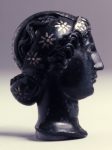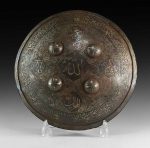Silver-inlay. There are many types of inlay and includes metals, gemstones and wood. This post is about silver inlaid into metals or other materials. Below are some examples of silver-inlay.
A silver-inlaid gilt bronze pear-shaped vase 18th century With beast mask and ring handles, decorated with lotus sprays on scrolling, leafy stems within borders of formal lappets and key-fret at the neck. 12cm (4.3/4in) high.
Sold for £ 2,000 inc. premium at Bonhams in 2018
Bronze head inlaid with silver. Roman Imperial Date: 1st Century – 2nd Century
Reference: © The Trustees of the British Museum
A SILVER-INLAID OXIDIZED COPPER RECTANGULAR SNUFF BOTTLE 1780-1900 One side of the flattened body is decorated in silver wire inlay with a figure seated at a table beneath a tree, the reverse with a calligraphic inscription, and the neck and narrow sides with shou characters. 2 1/8 in. (5.3 cm.) high, matching metal stopper and metal spoon
Sold for USD 875 at Christies in 2018
Islamic Silver-Inlaid Shield
Early 20th century AD. A large bronze shield with rolled rim and domed profile, concentric bands of silver-inlaid reserved calligraphic text and dense tendril patterns, central panel with calligraphic text and four similar surrounding, four bosses with rosette inlay securing loops to the reverse, suede lining. 2.2 kg, 39.5cm (15 1/2″).
Sold for £500 at TimeLine Auctions Ltd. in 2018
Ewer Circa 1180–1210 Attributed to Iran or Afghanistan, Khurasan or Herat
This ewer comes from a group of silver-inlaid brass vessels of similar shape and size decorated with a variety of imagery. While most of the examples have fluted sides and repoussé lions on their neck, the crowned harpies on the shoulder of this piece and the astrological imagery on its body heighten the auspiciousness of its ornament. Set in medallions of twisting vines terminating in rabbits’ heads, each zodiac sign appears with its ruling planet, enhancing its cosmic message.
Reference: The Metropolitan Museum of Art
Chinese Toggle Made in China, Asia, c. 1700-1940. Chinese belt toggles called ‘zhuizi’ are small carved ornaments used as counterweights on the cords of pipe bags and other small bags which were usually hung on men’s belts.
Reference: Museum of Applied Art and Sciences
Tsuba with design of dragons and pearls Japanese Edo period mid-late 18th century (?) Umetada Narimasa (Japanese), School Umetada School (Japanese)
Main material: iron; other metals: gold; silver-inlaid signature plaques; copper sekigane; decorative technique: sukashi-bori, maru-bori, zogan
Reference: Museum of Fine Arts Boston
An early Mamluk silver-inlaid brass bowl, Egypt, 14th century with large silver-inlaid engraved calligraphic band between foliage, interspersed with four roundels containing seated figures, the underside engraved with a central stylised sun motif surrounded by six roundels containing figures, remnants of silver inlay, incised swimming fish to interior 5cm. height.; 16cm. diam.
Sold for 51,250 GBP at Sothebys in 2019
Zitan wood cup, the exterior inlaid with a design of a flowering plant and a butterfly in silver wire and enamels, signed. Place of Origin China (made) Date ca. 1700-1750 (made)
Reference: © Victoria and Albert Museum
Ascetic Master Medium. copper alloy with copper and silver inlay (Metal)
This figure’s intense gaze signals his yogic power—through ascetic practices and the rejection of mainstream social conventions, he has mastered spiritual knowledge. The animal skin upon which he sits and the bone ornaments he wears—including his prominent spiral earrings—confirm his ascetic identity, but his sumptuous robe suggests a connection to worldly life. In his right hand he holds a “vajra,” a tantric Buddhist ritual implement that symbolizes the indestructibility and clarity of the enlightened mind. His left hand supports an auspicious vase, symbolizing abundance and longevity. An inscription on the back of the base praises the figure depicted as “one who has the power of wisdom and compassion,” but the epithets do not identify him with certainty. He may be the Tibetan Buddhist teacher and scholar Tsangnyon Heruka (1452–1507), who is similarly depicted with a goatee, spiral earrings, and elaborately piled hair. However, Tsangnyon typically holds a skull cup, and his clothing is usually limited to bone ornaments that only minimally cover his body, exposing a torso and belly that swell with yogic breath. The inlaid silver eyes were tarnished. The eyes were cleaned using precipitated chalk in a distilled water slurry. The eyes only were coated with a lacquer to reduce tarnishing. DATE DESCRIPTION NARRATIVE 6/27/2017 Examination Cleaned for exhibition. John and Berthe Ford, Baltimore; given to Walters Art Museum, 2002. [Inscription] མཁྱེན་རྩེའི་ནུས་ལྡན་མདོས་བདེ་མཚན་བཅན་ལ་ན་མོ། ; [Transliteration] Mkhyen rts’i nus ldan mdos bde mtshan bcan la na mo; [Translation] To the one who has the power of wisdom and compassion with the name Dode, I bow! Gift of John and Berthe Ford, 2002
Reference: The Walters Art Museum











